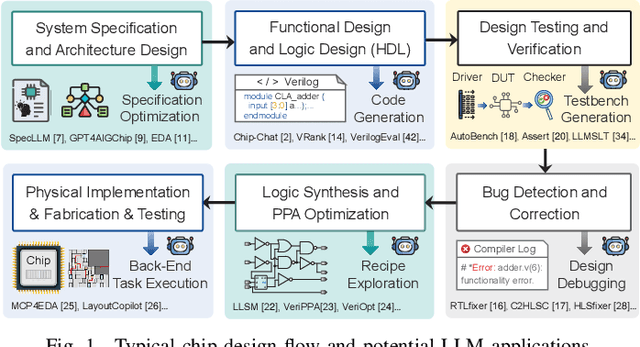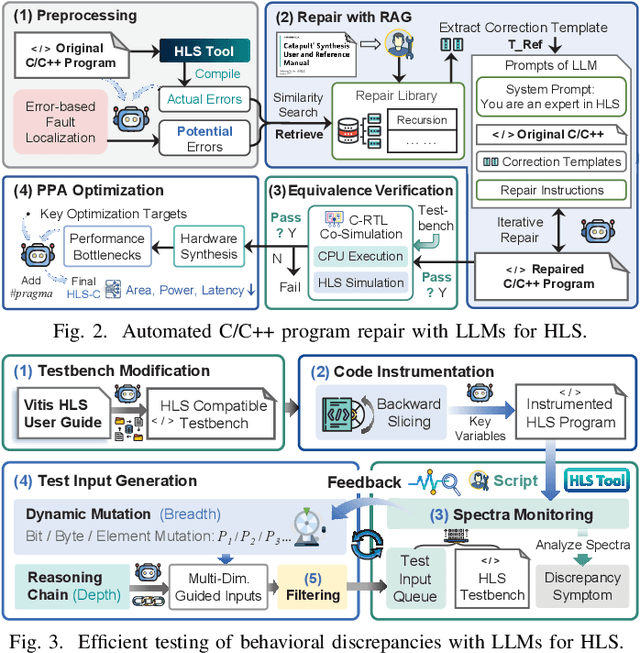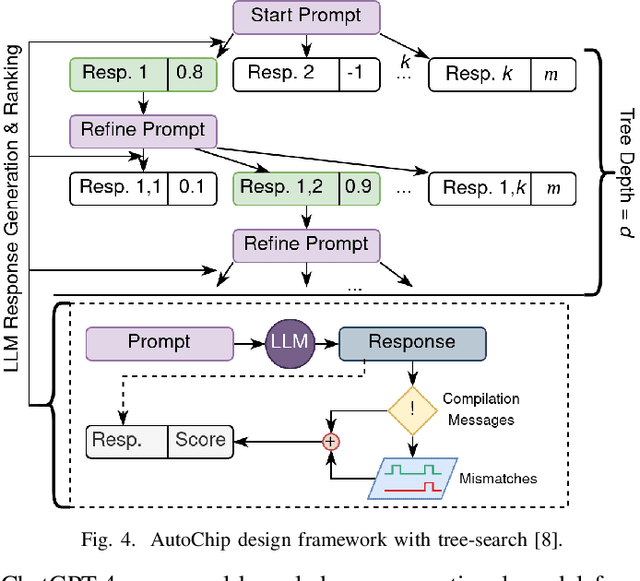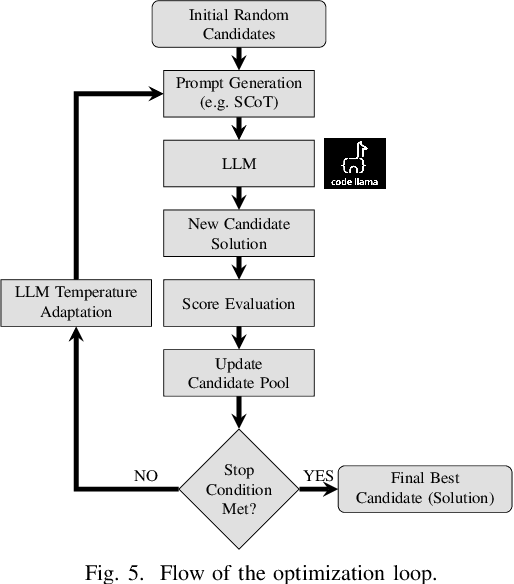Ramesh Karri
New York University
Large Language Models (LLMs) for Electronic Design Automation (EDA)
Aug 27, 2025



Abstract:With the growing complexity of modern integrated circuits, hardware engineers are required to devote more effort to the full design-to-manufacturing workflow. This workflow involves numerous iterations, making it both labor-intensive and error-prone. Therefore, there is an urgent demand for more efficient Electronic Design Automation (EDA) solutions to accelerate hardware development. Recently, large language models (LLMs) have shown remarkable advancements in contextual comprehension, logical reasoning, and generative capabilities. Since hardware designs and intermediate scripts can be represented as text, integrating LLM for EDA offers a promising opportunity to simplify and even automate the entire workflow. Accordingly, this paper provides a comprehensive overview of incorporating LLMs into EDA, with emphasis on their capabilities, limitations, and future opportunities. Three case studies, along with their outlook, are introduced to demonstrate the capabilities of LLMs in hardware design, testing, and optimization. Finally, future directions and challenges are highlighted to further explore the potential of LLMs in shaping the next-generation EDA, providing valuable insights for researchers interested in leveraging advanced AI technologies for EDA.
VeriLoC: Line-of-Code Level Prediction of Hardware Design Quality from Verilog Code
Jun 08, 2025Abstract:Modern chip design is complex, and there is a crucial need for early-stage prediction of key design-quality metrics like timing and routing congestion directly from Verilog code (a commonly used programming language for hardware design). It is especially important yet complex to predict individual lines of code that cause timing violations or downstream routing congestion. Prior works have tried approaches like converting Verilog into an intermediate graph representation and using LLM embeddings alongside other features to predict module-level quality, but did not consider line-level quality prediction. We propose VeriLoC, the first method that predicts design quality directly from Verilog at both the line- and module-level. To this end, VeriLoC leverages recent Verilog code-generation LLMs to extract local line-level and module-level embeddings, and train downstream classifiers/regressors on concatenations of these embeddings. VeriLoC achieves high F1-scores of 0.86-0.95 for line-level congestion and timing prediction, and reduces the mean average percentage error from 14% - 18% for SOTA methods down to only 4%. We believe that VeriLoC embeddings and insights from our work will also be of value for other predictive and optimization tasks for complex hardware design.
MapleGrasp: Mask-guided Feature Pooling for Language-driven Efficient Robotic Grasping
Jun 06, 2025Abstract:Robotic manipulation of unseen objects via natural language commands remains challenging. Language driven robotic grasping (LDRG) predicts stable grasp poses from natural language queries and RGB-D images. Here we introduce Mask-guided feature pooling, a lightweight enhancement to existing LDRG methods. Our approach employs a two-stage training strategy: first, a vision-language model generates feature maps from CLIP-fused embeddings, which are upsampled and weighted by text embeddings to produce segmentation masks. Next, the decoder generates separate feature maps for grasp prediction, pooling only token features within these masked regions to efficiently predict grasp poses. This targeted pooling approach reduces computational complexity, accelerating both training and inference. Incorporating mask pooling results in a 12% improvement over prior approaches on the OCID-VLG benchmark. Furthermore, we introduce RefGraspNet, an open-source dataset eight times larger than existing alternatives, significantly enhancing model generalization for open-vocabulary grasping. By extending 2D grasp predictions to 3D via depth mapping and inverse kinematics, our modular method achieves performance comparable to recent Vision-Language-Action (VLA) models on the LIBERO simulation benchmark, with improved generalization across different task suites. Real-world experiments on a 7 DoF Franka robotic arm demonstrate a 57% success rate with unseen objects, surpassing competitive baselines by 7%. Code will be released post publication.
CRAKEN: Cybersecurity LLM Agent with Knowledge-Based Execution
May 21, 2025



Abstract:Large Language Model (LLM) agents can automate cybersecurity tasks and can adapt to the evolving cybersecurity landscape without re-engineering. While LLM agents have demonstrated cybersecurity capabilities on Capture-The-Flag (CTF) competitions, they have two key limitations: accessing latest cybersecurity expertise beyond training data, and integrating new knowledge into complex task planning. Knowledge-based approaches that incorporate technical understanding into the task-solving automation can tackle these limitations. We present CRAKEN, a knowledge-based LLM agent framework that improves cybersecurity capability through three core mechanisms: contextual decomposition of task-critical information, iterative self-reflected knowledge retrieval, and knowledge-hint injection that transforms insights into adaptive attack strategies. Comprehensive evaluations with different configurations show CRAKEN's effectiveness in multi-stage vulnerability detection and exploitation compared to previous approaches. Our extensible architecture establishes new methodologies for embedding new security knowledge into LLM-driven cybersecurity agentic systems. With a knowledge database of CTF writeups, CRAKEN obtained an accuracy of 22% on NYU CTF Bench, outperforming prior works by 3% and achieving state-of-the-art results. On evaluation of MITRE ATT&CK techniques, CRAKEN solves 25-30% more techniques than prior work, demonstrating improved cybersecurity capabilities via knowledge-based execution. We make our framework open source to public https://github.com/NYU-LLM-CTF/nyuctf_agents_craken.
MARVEL: Multi-Agent RTL Vulnerability Extraction using Large Language Models
May 17, 2025Abstract:Hardware security verification is a challenging and time-consuming task. For this purpose, design engineers may utilize tools such as formal verification, linters, and functional simulation tests, coupled with analysis and a deep understanding of the hardware design being inspected. Large Language Models (LLMs) have been used to assist during this task, either directly or in conjunction with existing tools. We improve the state of the art by proposing MARVEL, a multi-agent LLM framework for a unified approach to decision-making, tool use, and reasoning. MARVEL mimics the cognitive process of a designer looking for security vulnerabilities in RTL code. It consists of a supervisor agent that devises the security policy of the system-on-chips (SoCs) using its security documentation. It delegates tasks to validate the security policy to individual executor agents. Each executor agent carries out its assigned task using a particular strategy. Each executor agent may use one or more tools to identify potential security bugs in the design and send the results back to the supervisor agent for further analysis and confirmation. MARVEL includes executor agents that leverage formal tools, linters, simulation tests, LLM-based detection schemes, and static analysis-based checks. We test our approach on a known buggy SoC based on OpenTitan from the Hack@DATE competition. We find that 20 of the 48 issues reported by MARVEL pose security vulnerabilities.
3D CAVLA: Leveraging Depth and 3D Context to Generalize Vision Language Action Models for Unseen Tasks
May 09, 2025Abstract:Robotic manipulation in 3D requires learning an $N$ degree-of-freedom joint space trajectory of a robot manipulator. Robots must possess semantic and visual perception abilities to transform real-world mappings of their workspace into the low-level control necessary for object manipulation. Recent work has demonstrated the capabilities of fine-tuning large Vision-Language Models (VLMs) to learn the mapping between RGB images, language instructions, and joint space control. These models typically take as input RGB images of the workspace and language instructions, and are trained on large datasets of teleoperated robot demonstrations. In this work, we explore methods to improve the scene context awareness of a popular recent Vision-Language-Action model by integrating chain-of-thought reasoning, depth perception, and task-oriented region of interest detection. Our experiments in the LIBERO simulation environment show that our proposed model, 3D-CAVLA, improves the success rate across various LIBERO task suites, achieving an average success rate of 98.1$\%$. We also evaluate the zero-shot capabilities of our method, demonstrating that 3D scene awareness leads to robust learning and adaptation for completely unseen tasks. 3D-CAVLA achieves an absolute improvement of 8.8$\%$ on unseen tasks. We will open-source our code and the unseen tasks dataset to promote community-driven research here: https://3d-cavla.github.io
Can Reasoning Models Reason about Hardware? An Agentic HLS Perspective
Mar 17, 2025



Abstract:Recent Large Language Models (LLMs) such as OpenAI o3-mini and DeepSeek-R1 use enhanced reasoning through Chain-of-Thought (CoT). Their potential in hardware design, which relies on expert-driven iterative optimization, remains unexplored. This paper investigates whether reasoning LLMs can address challenges in High-Level Synthesis (HLS) design space exploration and optimization. During HLS, engineers manually define pragmas/directives to balance performance and resource constraints. We propose an LLM-based optimization agentic framework that automatically restructures code, inserts pragmas, and identifies optimal design points via feedback from HLs tools and access to integer-linear programming (ILP) solvers. Experiments compare reasoning models against conventional LLMs on benchmarks using success rate, efficiency, and design quality (area/latency) metrics, and provide the first-ever glimpse into the CoTs produced by a powerful open-source reasoning model like DeepSeek-R1.
VeriContaminated: Assessing LLM-Driven Verilog Coding for Data Contamination
Mar 17, 2025Abstract:Large Language Models (LLMs) have revolutionized code generation, achieving exceptional results on various established benchmarking frameworks. However, concerns about data contamination - where benchmark data inadvertently leaks into pre-training or fine-tuning datasets - raise questions about the validity of these evaluations. While this issue is known, limiting the industrial adoption of LLM-driven software engineering, hardware coding has received little to no attention regarding these risks. For the first time, we analyze state-of-the-art (SOTA) evaluation frameworks for Verilog code generation (VerilogEval and RTLLM), using established methods for contamination detection (CCD and Min-K% Prob). We cover SOTA commercial and open-source LLMs (CodeGen2.5, Minitron 4b, Mistral 7b, phi-4 mini, LLaMA-{1,2,3.1}, GPT-{2,3.5,4o}, Deepseek-Coder, and CodeQwen 1.5), in baseline and fine-tuned models (RTLCoder and Verigen). Our study confirms that data contamination is a critical concern. We explore mitigations and the resulting trade-offs for code quality vs fairness (i.e., reducing contamination toward unbiased benchmarking).
VeriLeaky: Navigating IP Protection vs Utility in Fine-Tuning for LLM-Driven Verilog Coding
Mar 17, 2025



Abstract:Large language models (LLMs) offer significant potential for coding, yet fine-tuning (FT) with curated data is essential for niche languages like Verilog. Using proprietary intellectual property (IP) for FT presents a serious risk, as FT data can be leaked through LLM inference. This leads to a critical dilemma for design houses: seeking to build externally accessible LLMs offering competitive Verilog coding, how can they leverage in-house IP to enhance FT utility while ensuring IP protection? For the first time in the literature, we study this dilemma. Using LLaMA 3.1-8B, we conduct in-house FT on a baseline Verilog dataset (RTLCoder) supplemented with our own in-house IP, which is validated through multiple tape-outs. To rigorously assess IP leakage, we quantify structural similarity (AST/Dolos) and functional equivalence (Synopsys Formality) between generated codes and our in-house IP. We show that our IP can indeed be leaked, confirming the threat. As defense, we evaluate logic locking of Verilog codes (ASSURE). This offers some level of protection, yet reduces the IP's utility for FT and degrades the LLM's performance. Our study shows the need for novel strategies that are both effective and minimally disruptive to FT, an essential effort for enabling design houses to fully utilize their proprietary IP toward LLM-driven Verilog coding.
Survey of different Large Language Model Architectures: Trends, Benchmarks, and Challenges
Dec 04, 2024



Abstract:Large Language Models (LLMs) represent a class of deep learning models adept at understanding natural language and generating coherent responses to various prompts or queries. These models far exceed the complexity of conventional neural networks, often encompassing dozens of neural network layers and containing billions to trillions of parameters. They are typically trained on vast datasets, utilizing architectures based on transformer blocks. Present-day LLMs are multi-functional, capable of performing a range of tasks from text generation and language translation to question answering, as well as code generation and analysis. An advanced subset of these models, known as Multimodal Large Language Models (MLLMs), extends LLM capabilities to process and interpret multiple data modalities, including images, audio, and video. This enhancement empowers MLLMs with capabilities like video editing, image comprehension, and captioning for visual content. This survey provides a comprehensive overview of the recent advancements in LLMs. We begin by tracing the evolution of LLMs and subsequently delve into the advent and nuances of MLLMs. We analyze emerging state-of-the-art MLLMs, exploring their technical features, strengths, and limitations. Additionally, we present a comparative analysis of these models and discuss their challenges, potential limitations, and prospects for future development.
 Add to Chrome
Add to Chrome Add to Firefox
Add to Firefox Add to Edge
Add to Edge